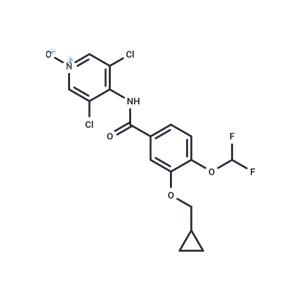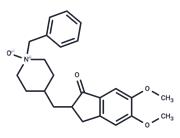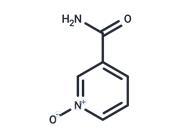| Name | Roflumilast N-oxide |
| Description | Roflumilast N-oxide is an inhibitor of PDE type 4. |
| Cell Research | A549 cells are washed and cultured overnight in serum-free F-12 K medium supplemented with antibiotics, L-glutamine and HEPES. The starved cells are incubated with Neutrophil elastase (NE) for 30 min or vehicle (PBS), washed with PBS and then cultured in serum free F-12 K. After stimulation, cell supernatants are collected at 24 h (for cytokine measurements) and cell pellets are collected after 2 h (for mRNA expression analysis). Alternatively, A549 cells are pre-incubated for 2 h with Roflumilast N-oxide (RNO) (at 0.1 μM, 0.3 μM and 1 μM), vehicle (DMSO 0.01%) prior to the addition of NE. All experiments are performed in serum-free medium in triplicate and are repeated at least three times. At the end of the incubation period, culture supernatants are harvested and stored at -80°C until further analysis |
| Animal Research | At 7 weeks of age, 16 h fasting mice receive a single oral dose of vehicle (4% methocel) or 10 mg/kg Roflumilast-N-oxide, and a glucose bolus of 2 g/kg body weight is co-administered as a physiological initiator for glucagon-like peptide-1 (GLP-1) secretion. Plasma GLP-1 is analyzed 60 min before, and 10 and 60 min after administration of Roflumilast-N-oxide and glucose. The effect of Roflumilast-N-oxide on plasma GLP-1 is also investigated in the absence of the glucose bolus |
| In vitro | Roflumilast N-oxide, at a concentration of 2 nM, partially counteracts the effects of cigarette smoke extract (CSE)-induced epithelial to mesenchymal transition (EMT) in WD-HBEC cells in vitro. It restores 45% of E-cadherin transcript expression adversely affected by CSE and suppresses the expression of collagen type I. Additionally, it protects the epithelial cell phenotype from CSE-induced alterations by co-incubation and partially mitigates the nuclear translocation of β-catenin through pre-incubation. |
| In vivo | A single administration of Roflumilast N-oxide at a dose of 10 mg/kg in db/db mice significantly increases plasma glucagon-like peptide-1 (GLP-1) levels by fourfold. Continuous treatment with 3 mg/kg of this compound effectively hinders disease progression in these mice, eliminating the rise in blood glucose, halving the rise in HbA1c, and doubling the level of fasted serum insulin compared to the control group, alongside preserving the structure of pancreatic islets. Furthermore, Roflumilast N-oxide enhances insulin release from primary islets stimulated by forskolin and demonstrates more potent glucose-lowering properties than its parent compound. |
| Storage | keep away from moisture,store at low temperature | Powder: -20°C for 3 years | In solvent: -80°C for 1 year | Shipping with blue ice/Shipping at ambient temperature. |
| Solubility Information | DMSO : 50 mg/mL (119.27 mM), Sonication is recommended.
|
| Keywords | Roflumilast N-oxide | Roflumilast Noxide | Roflumilast N oxide | Phosphodiesterase (PDE) | phosphodiesterase | PDE4 | Inhibitor | inhibit |
| Inhibitors Related | Theophylline monohydrate | Acefylline | Roflumilast | Theobromine | Apremilast | Isoprenaline hydrochloride | Indomethacin | Icariin | Theophylline | Vardenafil hydrochloride | Doxofylline | Sildenafil citrate |
| Related Compound Libraries | FDA-Approved & Pharmacopeia Drug Library | Anti-Neurodegenerative Disease Compound Library | Bioactive Compound Library | Approved Drug Library | Drug Repurposing Compound Library | Inhibitor Library | NO PAINS Compound Library | FDA-Approved Drug Library | Metabolism Compound Library | Bioactive Compounds Library Max | Bioactive Lipid Compound Library | Anti-Metabolism Disease Compound Library |

 United States
United States






